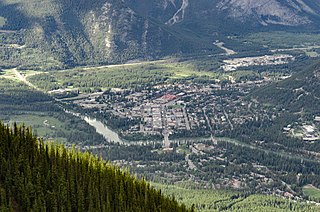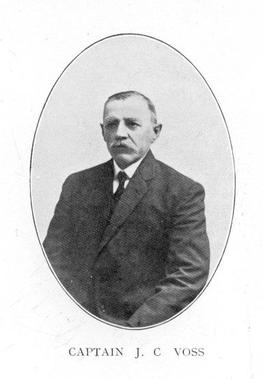
Banff National Park is Canada's oldest national park, established in 1885 as Rocky Mountains Park. Located in Alberta's Rocky Mountains, 110–180 kilometres (68–112 mi) west of Calgary, Banff encompasses 6,641 square kilometres (2,564 sq mi) of mountainous terrain, with many glaciers and ice fields, dense coniferous forest, and alpine landscapes. Provincial forests and Yoho National Park are neighbours to the west, while Kootenay National Park is located to the south and Kananaskis Country to the southeast. The main commercial centre of the park is the town of Banff, in the Bow River valley.

Banff is a town in Banff National Park, Alberta, Canada, in Alberta's Rockies along the Trans-Canada Highway, 126 km (78 mi) west of Calgary and 58 km (36 mi) east of Lake Louise, 1,400 to 1,630 m above sea level,
James Outram was a British clergyman, who made many first ascents in the Canadian Rockies in the early 1900s.

The Bow River is a river in Alberta, Canada. It begins within the Canadian Rocky Mountains and winds through the Alberta foothills onto the prairies, where it meets the Oldman River, the two then forming the South Saskatchewan River. These waters ultimately flow through the Nelson River into Hudson Bay. The Bow River runs through the city of Calgary, taking in the Elbow River at the historic site of Fort Calgary near downtown. The Bow River pathway, developed along the river's banks, is considered a part of Calgary's self-image.

The Glenbow Museum is an art and history regional museum in the city of Calgary, Alberta, Canada. The museum focuses on Western Canadian history and culture, including Indigenous perspectives. The Glenbow was established as a private non-profit foundation in 1955 by lawyer, businessman and philanthropist Eric Lafferty Harvie with materials from his personal collection.

Castle Mountain is a mountain located within Banff National Park in the Canadian Rockies, approximately halfway between Banff and Lake Louise. It is the easternmost mountain of the Main Ranges in the Bow Valley and sits astride the Castle Mountain Fault which has thrust older sedimentary and metamorphic rocks forming the upper part of the mountain over the younger rocks forming its base. The mountain's castellated, or castle-like, appearance is a result of erosive processes acting at different rates on the peak's alternating layers of softer shale and harder limestone, dolomite and quartzite.

Charles A. Beil LL. D. was a Canadian sculptor best known for his sculptures of cowboys and the plain Indians of the early West. He was a protégé and friend of artist Charles Marion Russell. He was born in Germany and left at the age of 11. He worked for some time in South America before making his way to North America, where he discovered his love of the Wild West and the Frontier. It was Russell who encouraged him to start creating art, and inspired him to start working with pencil and clay. Beil moved to Banff, Alberta in the 1930s, where he began to take an interest in casting clay into bronze.
Nicholas Sheran (1841–1882) was an entrepreneur born in New York City. He spent his early years apprenticing as a printer, working on Arctic whalers, and serving in the United States Army.
Duncan McGillivray, born in Inverness-shire, Scotland, was an explorer and fur trader in the Western Canada.

The Whyte Museum of the Canadian Rockies is located in Banff, Alberta, Canada. The museum collects, preserves, and exhibits materials related to the cultural heritage of the Rocky Mountains of Canada, making them available for education as well as research. The museum, which contains an archive and a library, was the inspiration of Banff artists Peter and Catharine Whyte. The Alpine Club of Canada has dedicated the Peter and Catharine Whyte Hut on the Peyto Glacier after the couple.

Peter and Catharine Whyte were twentieth-century Canadian artists from Banff, Alberta known for their landscape paintings of the Canadian Rockies. Their paintings and extensive collection of regional artifacts formed the genesis of what would later become the Whyte Museum of the Canadian Rockies. The Alpine Club of Canada dedicated the Peter and Catharine Whyte Hut on the Peyto Glacier after the couple.

Tilikum was a 38-foot (12 m) dugout canoe that was used in an effort to circumnavigate the globe starting in 1901. The boat was a "Nootkan" (Nuu-chah-nulth) canoe which was already old when she was obtained by captain John Voss in April 1901. The boat was built in the early 19th century as a dugout canoe made from a large red cedar log. Tilikum was purchased for $80 in silver from a native woman in a transference ceremony allegedly sealed by a bottle of rye whiskey - the name Tilikum means "friend" in Chinook jargon. Apparently, John Voss and his companion in this venture, Norman Luxton, were inspired by the voyage of Joshua Slocum, who sailed the 37-foot (11 m) sloop Spray around the world a few years earlier and wrote a best selling book about his adventures.
Tillicum or Tilikum is a word in Chinook Jargon that means people, family, tribe, and relatives, and may refer to:
Mînî Thnî is a First Nations settlement within the Stoney 142/143/144 Indian reserve in southern Alberta, Canada. It is located along the Canadian Pacific Kansas City railway between the Trans-Canada Highway and the Bow River, upstream from Ghost Lake. It has an elevation of 1,240 metres (4,070 ft). The settlement is located in census division No. 15 and in the federal riding of Wild Rose. The settlement and the Indian reserve are part of the Stoney Nation.
Hugh Aylmer Dempsey, was a Canadian historian, an author and the Chief Curator Emeritus of the Glenbow Museum in Calgary, Alberta. Dempsey authored more than 20 books, focusing primarily on the history of people of the Blackfoot Confederacy. He received an honorary doctorate from the University of Calgary and was made an honorary chief of the Kainai Blackfoot in 1967. For his contributions to the study of the Plains Indians, Dempsey was awarded membership in the Order of Canada in 1975.

John Claus Voss was a German-Canadian sailor best known for sailing around the world in a modified dug-out canoe he named Tilikum. Initially a carpenter, Voss apprenticed on a ship voyaging around Cape Horn and thereafter lived primarily as a sailor. In 1901 Voss began his most noteworthy voyage with his friend Norman Luxton and ending alone in 1904. He chronicled this and other notable voyages in The Venturesome Voyages of Captain Voss.

George Millward McDougall was a Methodist missionary in Canada who assisted in negotiations leading to Treaty 6 and Treaty 7 between the Canadian government and Indigenous nations of the prairies and what is now western Canada.

Mary Annora Brown L.L. D. (1899–1987), known as Annora Brown, was a Canadian visual artist whose work encompassed painting and graphic design. She was best known for her depictions of natural landscapes, wildflowers, and First Nations communities in Canada. Much of her work thematically explored Albertan identity, though she remained relatively obscure in discussions of Canadian art.
Nicholas Raphael de Grandmaison (1892–1978) was a Russian-born Canadian artist.

Terrance James Houle is an Internationally recognized Canadian interdisciplinary artist and member of the Kainai Nation and ancestry from the Sandy Bay Reservation, Manitoba. His Mother is Maxine WeaselFat from the Kainai Nation and Father Donald Vernon Houle from Sandy Bay Reservation in Manitoba, they are both 3rd generation Residential School attendees & reside on the Blood reservation in Southern Alberta, Canada. His work ranges from subversive to humorous absurdity to solemn and poetic artistic expressions. His work often relates to the physical body as it investigates issues of history, colonization, Aboriginal identity and representation in popular culture, as well as conceptual ideas based on memory, home, and reserve communities. Currently, He has co-directed a Short Animation Otanimm/Onnimm with his daughter Neko which is currently touring Film festivals, In Los Angeles, NYC, Toronto, New Zealand, Vancouver, Oxford & many more. Recently their short film won the prestigious Golden Sheaf Indigenous Award at Yorkton Film Festival and is Neko's First Award in Film at 17 years old.
















